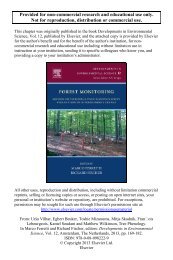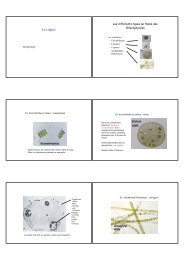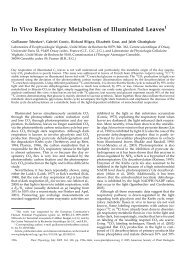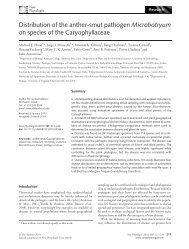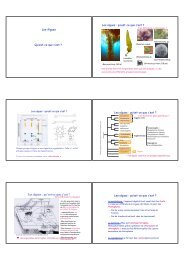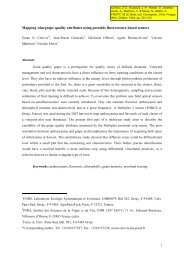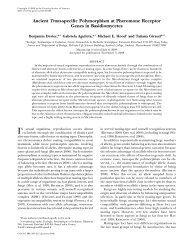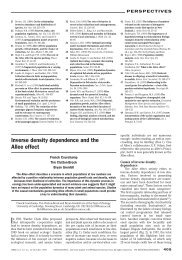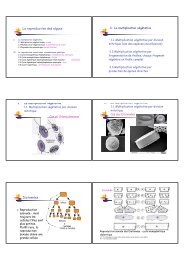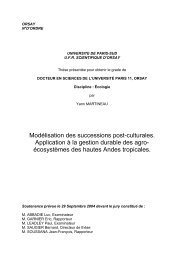Molecular phylogeny: pitfalls and progress
Molecular phylogeny: pitfalls and progress
Molecular phylogeny: pitfalls and progress
Create successful ePaper yourself
Turn your PDF publications into a flip-book with our unique Google optimized e-Paper software.
INTERNATL MICROBIOL (2000) 3:9–16<br />
© Springer-Verlag Ibérica 2000<br />
REVIEW ARTICLE<br />
9<br />
David Moreira<br />
Hervé Philippe<br />
UPRES-A 8080, Equipe Phylogénie et Evolution<br />
Moléculaires, Université Paris-Sud, France<br />
<strong>Molecular</strong> <strong>phylogeny</strong>: <strong>pitfalls</strong> <strong>and</strong><br />
<strong>progress</strong><br />
Received 13 September 1999<br />
Accepted 15 December 1999<br />
Correspondence to:<br />
David Moreira. División de Microbiología.<br />
Facultad de Medicina. Universidad Miguel<br />
Hernández. Campus de San Juan.<br />
03350 Alicante. Spain.<br />
Tel.: +34-965919451.<br />
Fax: +34-965919457.<br />
E-mail: David.Moreira@umh.es<br />
Summary <strong>Molecular</strong> <strong>phylogeny</strong> based on nucleotide or amino acid sequence<br />
comparison has become a widespread tool for general taxonomy <strong>and</strong> evolutionary<br />
analyses. It seems the only means to establish a natural classification of microorganisms,<br />
since their phenotypic traits are not always consistent with genealogy. After an optimistic<br />
period during which comprehensive microbial evolutionary pictures appeared, the<br />
discovery of several <strong>pitfalls</strong> affecting molecular phylogenetic reconstruction challenged<br />
the general validity of this approach. In addition to biological factors, such as horizontal<br />
gene transfer, some methodological problems may produce misleading phylogenies.<br />
They are essentially (i) loss of phylogenetic signal by the accumulation of overlapping<br />
mutations, (ii) incongruity between the real evolutionary process <strong>and</strong> the assumed<br />
models of sequence evolution, <strong>and</strong> (iii) differences of evolutionary rates among species<br />
or among positions within a sequence. Here, we discuss these problems <strong>and</strong> some<br />
strategies proposed to overcome their effects.<br />
Key words Phylogeny · Classification · Long branch attraction · rRNA trees · Sequence<br />
analysis<br />
Introduction<br />
Over almost five-sixths of its history, the Earth harbored only<br />
microbial life. Contrary to the more recent period of metazoan<br />
evolution, this vast time span left much less fossil information.<br />
The absence of a fossil record hindered the establishment of a<br />
reliable framework of the evolutionary relationships among<br />
microorganisms. In addition, <strong>and</strong> especially within prokaryotes,<br />
analysis of phenotypic traits proved of little phylogenetic value.<br />
Only the definition of low-rank taxa (species, genera, <strong>and</strong> some<br />
families) was meaningful. Attempts to generate higher-order<br />
phylogenetic schemes led to rather artificial groupings, such<br />
as the “photosynthetic bacteria”. This situation was less dramatic<br />
for eukaryotic microorganisms. Some important groups could<br />
be defined on the basis of particular shared phenotypic traits,<br />
even in the rank of phyla <strong>and</strong> kingdoms, such as the ciliates,<br />
apicomplexans, or kinetoplastids. However, the elucidation of<br />
their phylogenetic relationships <strong>and</strong> the delineation of<br />
supergroups also remained largely conjecture. Thus, as recently<br />
as 1963, Stanier <strong>and</strong> co-workers sadly declared that “…the<br />
ultimate scientific goal of biological classification cannot be<br />
achieved in the case of bacteria” [45].<br />
Shortly after, Zuckerk<strong>and</strong>l <strong>and</strong> Pauling realized that the<br />
primary sequences of nucleic acids <strong>and</strong> proteins contained a<br />
rich source of information about the evolutionary history, which<br />
could be retrieved by sequence alignment <strong>and</strong> comparison [59].<br />
The era of molecular <strong>phylogeny</strong> was born <strong>and</strong>, with it, our<br />
approach to the analysis of microbial evolution changed. The<br />
revolutionary power of these molecular methods became<br />
obvious thirteen years later, when Woese <strong>and</strong> Fox [56] published<br />
the analyses of a significant number of organisms based on 16S<br />
ribosomal RNA (rRNA) sequences (initially as oligonucleotide<br />
catalogues <strong>and</strong>, later on, as complete sequences). The most<br />
significant outcome of this analysis was the recognition of a<br />
tripartite division of the living world. A third group<br />
encompassing some obscure weird prokaryotes (extreme<br />
thermoacidophiles, methanogens, <strong>and</strong> extreme halophiles)<br />
emerged as an independent branch in the tree of life, together<br />
with classic bacteria <strong>and</strong> eukaryotes. The scheme of the three<br />
primary kingdoms (Eubacteria, Eukaryotes, <strong>and</strong> Archaebacteria,<br />
later reclassified as the Domains Bacteria, Eucarya, <strong>and</strong><br />
Archaea) was born. Though still controversial [11, 30, 32], this<br />
view currently prevails. Due to their universal distribution <strong>and</strong><br />
evolutionary conservation, the rRNAs have become the<br />
reference markers for studies of molecular <strong>phylogeny</strong>. Using<br />
rRNA comparisons, the phylogenetic relationships among the<br />
major prokaryotic <strong>and</strong> eukaryotic taxa have been obtained [44,<br />
54]. As a consequence, phylogenetic taxonomy has replaced<br />
almost completely classical taxonomic approaches, <strong>and</strong> a huge<br />
database of rRNA sequences has been generated.<br />
However, the optimistic view that molecular <strong>phylogeny</strong> would<br />
answer most evolutionary questions was soon challenged. In fact,<br />
the subsequent use of alternative phylogenetic markers often
10 INTERNATL MICROBIOL Vol. 3, 2000 Moreira, Philippe<br />
resulted in different <strong>and</strong> conflictive pictures. Confusing results<br />
were then obtained, making it difficult to choose the “correct”<br />
<strong>phylogeny</strong>. Hence, at present, the <strong>phylogeny</strong> of many prokaryotic<br />
<strong>and</strong> eukaryotic taxa remains unsolved. Several factors that account<br />
for these incongruencies have a biological origin, such as<br />
horizontal gene transfers [31, 49] <strong>and</strong> gene duplications followed<br />
by r<strong>and</strong>om independent gene losses [57]. Other factors involved<br />
are tree reconstruction artifacts that arise from incorrect<br />
assumptions of the evolutionary models applied, <strong>and</strong> from the<br />
limitations of both the data available <strong>and</strong> the methods currently<br />
used for reconstructing molecular phylogenies. In this review, we<br />
summarize different problems that may cause artefactual<br />
phylogenies. We analyze their origin <strong>and</strong> suggest possible<br />
strategies to elude them or to alleviate their negative effects.<br />
Mutational saturation <strong>and</strong> the decay of the<br />
phylogenetic signal<br />
One of the corollaries of Zuckerk<strong>and</strong>l <strong>and</strong> Pauling’s work was<br />
that sequence divergence occurs in a time-dependent manner<br />
so that the accumulation of mutations is proportional to time. This<br />
idea permeated the scientific community as the concept of an<br />
“evolutionary clock” [20] <strong>and</strong> is still applied at present. However,<br />
when phylogenies covering long-time spans are examined,<br />
sequence positions may have accumulated so many mutations<br />
that the present bases or amino acids are essentially r<strong>and</strong>om, <strong>and</strong><br />
therefore contain scant or no evolutive information. These are<br />
mutationally saturated positions. A similar case may occur for<br />
shorter-time spans but fast-evolving positions or fast-evolving<br />
sequences. A clear example corresponds to the third codon<br />
positions of protein coding sequences, though mutational saturation<br />
can even affect complete sequences depending on their particular<br />
evolutionary constraints. In fact, the less a molecule is selectively<br />
constrained, the faster it will accumulate mutations <strong>and</strong> the faster<br />
the ancient phylogenetic information will change or disappear.<br />
When measured in evolutionary time scales, such fast-evolving<br />
positions or molecules exhibit a small signal-to-noise ratio <strong>and</strong><br />
have little phylogenetic value, producing misleading phylogenetic<br />
reconstructions. How can mutational saturation be detected<br />
A simple strategy takes advantage of the ability of the<br />
maximum parsimony (MP) or maximum likelihood (ML)<br />
methods to correct for multiple substitutions <strong>and</strong> to estimate<br />
their approximate number. The number of substitutions thus<br />
inferred for a pair of sequences can be plotted against the<br />
number of observed differences for that pair. When this is done<br />
for all possible pairs of sequences of a data set, a saturation<br />
diagram is obtained [39]. Figure 1 shows a typical saturation<br />
diagram calculated for forty 16S rRNA sequences from diverse<br />
bacteria. The diagonal of the diagram corresponds to the ideal<br />
case of sequences that have undergone no more than one<br />
substitution per position, while the points at the right of the<br />
diagonal represent sequences that have undergone more than<br />
one substitution per position (i.e. multiple substitutions). A<br />
significant amount of points is far from the diagonal, indicating<br />
that the data set is saturated. In general, data sets corresponding<br />
to a broad taxonomic samplings are more saturated than those<br />
corresponding to more restricted taxonomic samplings. This<br />
is the reason why, usually, the uncertainty is higher for largescale<br />
phylogenies (more saturated) than for lower-order<br />
phylogenies (less saturated). Nevertheless, note that in most<br />
cases even the MP or ML methods are not able to detect all the<br />
multiple substitutions that affect a given data set, since they<br />
use oversimplified <strong>and</strong> often unrealistic models of sequence<br />
evolution. Therefore, the number of inferred substitutions is<br />
usually an underestimation of the true number of substitutions<br />
(although much more accurate than the observed substitutions).<br />
The problem of modeling the evolution<br />
of sequences: compositional biases,<br />
among-site rate variation, <strong>and</strong> other<br />
sources of phylogenetic inconsistency<br />
Tree reconstruction methods make use of diverse models of<br />
sequence evolution, each having different assumptions <strong>and</strong> degrees<br />
of complexity. As commented above, the application of accurate<br />
models is crucial to estimate the number of multiple substitutions<br />
<strong>and</strong>, therefore, the problem of mutational saturation.<br />
Oversimplified models underestimate this number as well as the<br />
level of homoplasy (the fortuitous sharing of character states due<br />
Fig. 1 Mutational saturation diagram for a data set of 16S rRNA sequences<br />
from 40 species covering almost all the bacterial taxonomic diversity. The<br />
number of inferred substitutions was estimated by maximum parsimony<br />
analysis. The diagonal corresponds to the ideal cases for which no more than<br />
one substitution per position has occurred
<strong>Molecular</strong> <strong>phylogeny</strong> INTERNATL MICROBIOL Vol. 3, 2000<br />
11<br />
to back replacements or convergence <strong>and</strong> not to common ancestry)<br />
of a data set. Consequently, the similarity of nucleotide<br />
composition rather than genuine phylogenetic signal may lead in<br />
certain cases to the clustering of unrelated taxa. This was one<br />
of the first <strong>pitfalls</strong> discovered in rRNA phylogenies. For instance,<br />
the sequences of some protists that emerge early in rRNA trees<br />
turned out to have extreme G + C values, <strong>and</strong> the reliability of<br />
their phylogenetic position was questioned [27]. In contrast to<br />
nucleotide sequences, when the amino acid sequences are<br />
employed as markers the codon degeneracy supplies a mechanism<br />
that naturally absorbs to some extent these G + C drifts. By this<br />
reason, some authors consider protein sequences more reliable<br />
<strong>and</strong> suitable for phylogenetic analysis [14, 46]. However, if<br />
analyzed with an unfitted model, even the phylogenies constructed<br />
using protein sequences may be biased, in this case by amino acid<br />
composition. A clear example is the <strong>phylogeny</strong> of chloroplasts,<br />
for which the different relative amino acid compositions found<br />
in the distinct lineages constitutes an important biasing factor for<br />
tree topology [26].<br />
Researchers have tried to overcome that problem with<br />
different approaches. The most obvious is the use of taxonomic<br />
samples whose sequences have similar nucleotide or amino<br />
acid compositions [5, 23]. However, this is not always possible<br />
<strong>and</strong>, in this case, data can be transformed to reduce the<br />
sensitivity of the analysis to compositional bias. For rRNA<br />
sequences, bases can be recoded as purine (A, G) vs. pyrimidine<br />
(C, T), <strong>and</strong> only information from transversion events used<br />
[55]. For protein sequences, amino acids can also be recoded<br />
according to groups of similar biochemical characteristics<br />
(e.g. V = I, L = M, K = R, etc.) [35]. Obviously, this approach<br />
does not solve all possible biases [24]. Several attempts have been<br />
made to develop methods that accommodate biased nucleotide<br />
<strong>and</strong> amino acid frequencies. One example is the use of paralinear<br />
distances, which produce values that are more directly comparable<br />
to st<strong>and</strong>ard genetic distances [21, 46].<br />
In addition to compositional bases, another source of<br />
inconsistency arising from oversimplified models of sequence<br />
evolution is among-site rate variation. Simplistic models assume<br />
that the probability for a position to change is roughly equal<br />
for all sites in a sequence. However, some sites are often more<br />
prone to undergo changes than others, i.e. the evolutionary rate<br />
varies among sequence sites. A clear example is the presence<br />
of invariant sites, whose impact on phylogenetic reconstruction<br />
was also among the first problems detected. For instance, their<br />
inclusion in phylogenetic analyses of chloroplast evolution led<br />
to inconsistent results, even when these sites were noninformative<br />
for phylogenetic purposes due to their identity in<br />
all sequences [25]. The <strong>progress</strong>ive elimination of an increasing<br />
percentage of invariant sites produced more consistent results,<br />
presumably due to a more uniform distribution of evolutionary<br />
rates among sites [25]. Yang proposed a simple model to account<br />
for invariant sites in which characters are classified into two<br />
categories “not variable” <strong>and</strong> “variable”, with the same<br />
evolutionary rate for all variable sites [58]. However, this model<br />
is still oversimplified, since the evolutionary rate can vary<br />
enormously among variable sites. A model that copes more<br />
successfully with this problem is the gamma rate distribution,<br />
which takes into account a wide range of rates. Evolutionary rates<br />
<strong>and</strong> number of positions evolving at different rates can be plotted<br />
to generate a curve. A parameter, α, of the gamma distribution<br />
accounts for the shape of this curve, <strong>and</strong> varies between 0 <strong>and</strong><br />
infinite. If α is large, all sites evolve roughly at the same rate,<br />
whereas if it is small, many sites evolve slowly, <strong>and</strong> only a few<br />
of them evolve rapidly. The use of this model allows much more<br />
accurate distance calculations than classical models, <strong>and</strong> is now<br />
widely used [58]. A combined approach of invariant sites plus<br />
a gamma distribution, which consists of the exclusion of the<br />
invariant sites applying a gamma distribution for the variable sites,<br />
seems also very useful in some situations [47].<br />
A method that also assumes different rates among sites was<br />
specifically developed for the analysis of rRNA sequences [52].<br />
The availability of huge data sets for the different rRNAs has<br />
allowed the construction of variability maps for these molecules.<br />
The degree of variability of each site is estimated from the<br />
aligned sequences. Then, for the inference of phylogenetic<br />
trees, a particular weight is given to each site which is inversely<br />
proportional to the variability of the site. Slow-evolving sites<br />
thus have more weight than fast-evolving ones. This method<br />
was successfully used to identify the sister-group of the fastevolving<br />
nucleomorphs, the secondary photosynthetic<br />
endosymbionts of the chlorarachniophytes [51].<br />
The search for more accurate models is a very active area of<br />
research in phylogenetics. New approaches based on more realistic<br />
assumptions are under development. Among these, the covarion<br />
model which is most promising. Fitch advanced this model in the<br />
early 1970s by stating that the evolutionary rate of each position<br />
can vary through time [7]. This possibility is not currently<br />
considered by the st<strong>and</strong>ard among-site rate variation models, making<br />
them sometimes inefficient. Any given site may be variable in<br />
some parts of the tree but constant in others. This may explain the<br />
differences in the distribution of invariant sites or in the number<br />
of variable sites among different lineages. At present, it is probably<br />
the most realistic approach to model the non-stationarity of the<br />
evolutionary process. In fact, the evolution patterns of several<br />
molecules, such as the rRNAs [53] or the elongation factors [28],<br />
seem to fit a covarion model. However, the mathematical<br />
implementation of this model is very difficult, <strong>and</strong> tree reconstruction<br />
methods based on this model are not yet available [50].<br />
The long branch attraction artifact<br />
Soon after molecular <strong>phylogeny</strong> techniques become widespread,<br />
Felsenstein described a major artifact in the tree reconstruction:<br />
the long branch attraction (LBA), which was observed whenever<br />
the evolutionary rates were different among the different species<br />
[6]. Fast-evolving sequences are more prone to share identical<br />
character states by chance (false synapomorphies) than slow-
12 INTERNATL MICROBIOL Vol. 3, 2000 Moreira, Philippe<br />
evolving sequences. In the absence of adequate models of<br />
sequence evolution, this problem is not corrected, <strong>and</strong> the fastevolving<br />
sequences will be grouped together irrespective of their<br />
true relationships. The parameter combination within which a<br />
particular method results are inconsistent because of LBA is<br />
referred to as the “Felsenstein-zone” [48]. All current models are<br />
more or less oversimplified <strong>and</strong>, as a consequence, LBA is a very<br />
common phenomenon whenever differences of evolutionary rate<br />
among sequences exist. An additional problem is that the outgroup<br />
is frequently itself a long branch, so that the fast-evolving ingroup<br />
sequences are not only attracted among themselves but also by<br />
the outgroup. This leads to their misplacement towards the base<br />
of the tree. Mutational saturation exacrebates the problem <strong>and</strong>,<br />
if the differences of rate among species are high, the LBA can<br />
produce robust misleading phylogenies [40]. Rate differences<br />
may correspond to several orders of magnitude [36]. These artifacts<br />
are a major source of uncertainty in current molecular <strong>phylogeny</strong>.<br />
Our view of the evolution of certain groups has been unfortunately<br />
influenced through unrecognized <strong>and</strong> incorrect phylogenies<br />
resulting from LBA.<br />
An excellent example is the phylum Microsporidia. These<br />
protists are unusual <strong>and</strong> divergent parasites that lack mitochondria<br />
<strong>and</strong> branch at the base of the eukaryotic small subunit (SSU)<br />
rRNA tree [23]. Accordingly, for a long time they were considered<br />
as living relics of the premitochondrial phase of eukaryote<br />
evolution. However, genes of unambiguous mitochondrial origin<br />
have been recently discovered in their genomes [8, 18].<br />
Furthermore, several protein markers place them as close relatives<br />
of fungi [reviewed in 34]. This relationship is also supported by<br />
the presence of chitin in their spore wall <strong>and</strong> by similarities in<br />
their life cycle to that of several fungi [34]. Therefore, these protists<br />
are actually a group of fungi that have experienced a strong<br />
increase in the evolutionary rate of some genes (such as their SSU<br />
rRNA). This is most likely due to their parasitic way of life,<br />
characterized by a reduction of metabolic activity <strong>and</strong> selective<br />
constraints, <strong>and</strong> major changes in the structures of populations<br />
[34]. The increased evolutionary rate explains their basal<br />
phylogenetic position as a result of an LBA artifact. Another<br />
example is found in the bacterial group comprising the<br />
thermophilic genus Thermus <strong>and</strong> the radio-resistant genus<br />
Deinococcus, which branches early in the SSU rRNA bacterial<br />
tree [54]. According to Gupta, recent protein data analyses,<br />
including the detection of some specific deletions <strong>and</strong> insertions,<br />
suggest that these genera are actually close relatives of the<br />
cyanobacteria [12]. In this case, the force leading to the<br />
acceleration of the evolutionary rate might have been the<br />
adaptation to the harsh environments inhabited by these organisms.<br />
Long branch attraction, tree shape, <strong>and</strong><br />
the effects of taxonomic sampling<br />
A simple parameter used to describe tree topology is symmetry.<br />
A symmetric tree is perfectly bifurcated, whereas an asymmetric<br />
tree is ladder-shaped (Fig. 2). The tree symmetry is measured<br />
by an index ranging from 0, for a completely symmetric tree,<br />
to 1, for a completely asymmetric tree [16]. Since the LBA<br />
artifact tends to attract the fast-evolving taxa out of their actual<br />
phyletic groups towards the base of the tree, it gives rise for<br />
more asymmetric topologies (Fig. 2). This effect is stronger<br />
the more distant the outgroup. In fact, when very distant<br />
outgroups are used, the fast-evolving taxa usually appear as<br />
independent branches at the base of the tree whereas, when<br />
close outgroups are used, the fast-evolving taxa often are<br />
artefactually grouped together at the base of the tree [40].<br />
Accordingly, very asymmetric trees may suggest the existence<br />
of LBA artifacts.<br />
One important consequence of the weakness of the<br />
phylogenetic signal due to the combination of the mutational<br />
saturation <strong>and</strong> the unequal evolutionary rates among species<br />
is the taxonomic sampling effect [22]. A priori, the relative<br />
branching order of the taxonomic groups in a <strong>phylogeny</strong><br />
should not vary depending on the particular species of these<br />
groups included in the analysis. However, very often this is<br />
not the case, especially when small data sets are used [38].<br />
For instance, the accepted <strong>phylogeny</strong> of the α, β, γ, <strong>and</strong> δ<br />
subdivisions of the Proteobacteria displays the topology shown<br />
in Fig. 3A, where the β <strong>and</strong> γ subdivisions are sister-groups.<br />
However, by using particular representatives of these<br />
subdivisions, phylogenetic trees where the α <strong>and</strong> β subdivisions<br />
are sister-groups can be obtained (Fig. 3B). Underlying these<br />
contradictory phylogenies is, once again, the existence of<br />
unequal evolutionary rates among species, which produces<br />
LBA artifacts. Thus, any group represented by a fast-evolving<br />
species is likely to show an equivocal early position in the<br />
tree, often misleading the relationships among the other<br />
groups.<br />
Can long branches be detected<br />
An inherent problem in the misplacement of the fast evolving<br />
sequences towards the base of the tree by LBA is that these<br />
branches are not easily recognized as excessively long<br />
(Fig. 2). A possible solution is the a priori analysis of the<br />
evolutionary rates of the different sequences in order to detect<br />
the fast evolving ones. A mathematically simple test, the<br />
relative rate test, was developed for this purpose [42]. It<br />
consists of the comparison of the distances of two sequences<br />
to a third one, the outgroup. If both distances are equivalent,<br />
then it is assumed that the two sequences have similar<br />
evolutionary rates. If distances are dissimilar, the most<br />
divergent sequence is considered the fastest evolving one.<br />
However, it has been recently demonstrated that this test has<br />
severe limitations when applied to saturated data sets.<br />
Saturation leads to a more severe underestimation of longer<br />
pairwise distances relative to shorter distances [9] <strong>and</strong>,<br />
therefore, the number of differences observed between pairs
<strong>Molecular</strong> <strong>phylogeny</strong> INTERNATL MICROBIOL Vol. 3, 2000<br />
13<br />
Fig. 2 Tree symmetry<br />
<strong>and</strong> the effects of long<br />
branch attraction<br />
(LBA). A perfectly<br />
bifurcated or<br />
symmetric tree (left)<br />
may be artefactually<br />
retrieved by molecular<br />
phylogenetic analysis<br />
as a ladder-shaped or<br />
asymmetric tree (right)<br />
if there are strong<br />
differences of<br />
evolutionary rate<br />
among species. The<br />
fast-evolving species<br />
are misplaced towards<br />
the base of the tree<br />
decreasing the tree<br />
symmetry<br />
of sequences will not reflect the true number of substitutions.<br />
Hence, although their rates may be very different, the result<br />
of the relative rate test will be always that these sequences<br />
have similar rates. As a result, saturated data sets suggest a<br />
false clock-like behavior, especially when using distant<br />
outgroups [40].<br />
Alternative methods to cope with the problem of detecting<br />
fast-evolving species have been developed. Perhaps the most<br />
popular is the use of improved methods for the correction of<br />
Fig. 3 The effect of taxonomic sampling. (A) A correct 16S rRNA four-species<br />
tree where β <strong>and</strong> γ proteobacterial representatives are sister-groups. (B) An<br />
incorrect tree where α <strong>and</strong> β proteobacterial representatives are sister-groups.<br />
(C) The addition of sequences to the incorrect <strong>phylogeny</strong> allows the retrieval<br />
of a correct tree. The bars correspond to 10 nucleotide substitutions<br />
distances that allow more accurate estimations of the number<br />
of substitutions. Several correction methods, based on diverse<br />
assumptions about the process of sequence evolution, are<br />
currently used. Although their detailed analysis falls out of the<br />
scope of this work, it is worth noting that the trees retrieved<br />
under the most accurate corrections for a given data set show<br />
most clearly the differences of evolutionary rates (i.e. the<br />
differences of branch length) among species. For instance, a<br />
simple method based on both the removal of the constant<br />
positions of the alignment <strong>and</strong> the construction of the <strong>phylogeny</strong><br />
using only the variable positions, can be most useful to detect<br />
the fast evolving species [25]. However, at present, the most<br />
often used approach is the correction for among-site rate<br />
variation using a gamma law (see above), since the existence<br />
of very dissimilar substitution rates for different positions in a<br />
sequence appears ubiquitous [58]. Although the estimation of<br />
the correct parameters of the gamma distribution is often<br />
problematic, this method has allowed the reconstruction of<br />
phylogenies for which the classical methods produced robustly<br />
wrong trees [47].<br />
Recently, a new method for the detection of fast evolving<br />
sequences, the RASA test, based on statistical measure of<br />
phylogenetic signal in character state matrices, has been<br />
developed [29]. However, this method is also endowed with<br />
important limitations. Slow–evolving sequences are interpreted<br />
as fast–evolving ones whenever they are included in data sets<br />
with a majority of actually fast–evolving sequences<br />
(unpublished observations). A very simple alternative approach<br />
that has been proven useful consists of the determination of the<br />
number of variable positions for the different taxonomic groups<br />
analyzed. Contrary to the current assumptions, the acceleration<br />
of the evolutionary rate is due not only to the acceleration of<br />
the substitution rate of the variable positions, but also to an<br />
increase in the number of variable positions. Therefore,<br />
fast–evolving groups are usually characterized by a larger<br />
number of variable positions [33]. This amplifies the effect<br />
of the LBA artifact, but in turn allows the identification of<br />
fast–evolving groups.
14 INTERNATL MICROBIOL Vol. 3, 2000 Moreira, Philippe<br />
How to cope with the long-branch<br />
attraction<br />
The addition of more sequences belonging to fast-evolving<br />
groups to “break” their long branches was among the first means<br />
suggested to reduce the LBA artifact [17]. Some of the positions<br />
shared at r<strong>and</strong>om by a fast-evolving sequence <strong>and</strong> the outgroup<br />
may not be shared with the additional sequences, thus<br />
decreasing the LBA effect. This approach is particularly efficient<br />
for phylogenies constructed using a few species, such as the<br />
example shown in Fig. 3B. When the proteobacterial <strong>phylogeny</strong><br />
is constructed using all the species (even those producing<br />
mislead phylogenies in the examples containing only four taxa)<br />
a correct tree is obtained (Fig. 3C). However, increasing the<br />
number of sequences may not completely overcome LBA<br />
problems, <strong>and</strong> may even decrease the consistency of the<br />
phylogenies [19]. An example is the protist <strong>phylogeny</strong> based<br />
on elongation factor 1α (EF-1α) sequences, which shows an<br />
artefactual polyphyly of ciliates. The addition of several new<br />
ciliate sequences did not allow the retrieval of the monophyly<br />
of ciliates, but did lead to a decrease in the statistical support<br />
in several nodes of the tree [33]. Note that this decrease affected<br />
especially the least reliable parts of the tree (e.g. those<br />
containing the polyphyletic fast-evolving ciliate branches).<br />
This reveals that the decrease of support subsequent to an<br />
addition of sequences may be an indicator of artifacts in<br />
phylogenies. Statistically well-sustained reliable nodes are less<br />
affected by this decrease [33]. Note here that a consistent node<br />
is not necessarily a correct node. Several tree reconstruction<br />
artifacts, notably the LBA, can produce consistent but incorrect<br />
topologies. For instance, the very early emergence of<br />
Microsporidia in rRNA trees is consistently supported by high<br />
bootstrap values [23]. However, this result is artefactual since<br />
Microsporidia are actually close relatives of fungi (see above).<br />
The most effective approach to the study of large numbers<br />
of taxa is to focus on slow-evolving sequences [19]. A<br />
noticeable example comes from the metazoan <strong>phylogeny</strong><br />
constructed by using the SSU rRNA, for which only the use of<br />
slow-evolving species allows the location of nematodes as<br />
sister-group of arthropods <strong>and</strong> not as early-emerging animals<br />
[1]. However, the lack of a priori criteria is a hindrance to<br />
foresee the evolutionary rate of any given sequence. The only<br />
practical approach to solve this problem is to increase the<br />
number of sequences with the hope that this will also include<br />
slow-evolving sequences. Careful selection of these among all<br />
available sequences can be of great help. At any rate, if slowevolving<br />
sequences are not available, the best approach is the<br />
use of as many sequences as possible.<br />
Another major variable that researchers can modify in several<br />
cases is the distance to the outgroup. Since the LBA produces the<br />
attraction of the fast-evolving taxa towards the base, the choice<br />
of the closest outgroup is highly recommended to reduce the<br />
impact of this artifact. In addition, the observation of changes of<br />
the tree topology related to changes in the outgroup is an evidence<br />
of the existence of LBA artifacts. For instance, if we consider<br />
again the general <strong>phylogeny</strong> of eukaryotes, the use of<br />
mitochondrial markers often produces much more symmetric<br />
trees than those constructed using nuclear sequences [see, for<br />
instance, 8, 10, 18]. Since LBA <strong>and</strong> tree asymmetry are directly<br />
related to each other, that asymmetry reveals LBA artifacts<br />
affecting eukaryotic <strong>phylogeny</strong>. The results obtained by using<br />
mitochondrial markers are due to the fact that the outgroup, the<br />
α-Proteobacteria, seems to be closer to the ingroup than the<br />
outgroups for nuclear markers.<br />
The selection of an adequate tree reconstruction method can<br />
also help to avoid or alleviate LBA problems. Different<br />
reconstruction algorithms do not have the same ability to cope<br />
with fast-evolving sequences. In fact, ML methods are the most<br />
effective, whereas MP methods seem to be the most sensitive<br />
when a small number of taxa is used [13]. However, ML methods<br />
are very computationally expensive, which makes their use with<br />
large numbers of taxa almost impossible. This is a practical<br />
problem, since large data sets usually produce more reliable results.<br />
Our group developed recently a simple method (the Slow-<br />
Fast method) that allows the detection of fast-evolving species<br />
<strong>and</strong> provides information about their position in phylogenetic<br />
trees [3]. The method is based on the reconstruction of phylogenies<br />
by using only the slow-evolving positions of the alignment for<br />
each taxonomic group. The number of substitutions is computed<br />
for each position within each taxonomic group. Subsequently,<br />
different distance matrices (the “Slow-matrices”) are built using<br />
the information from positions which undergo either no changes,<br />
or one, two or even more changes per group. A priori, the<br />
phylogenetic information contained in these slow-evolving<br />
positions is of the best quality, especially for ancient events.<br />
However, this information is frequently overwhelmed by the<br />
mutationally saturated fast-evolving positions, which are usually<br />
the majority of positions in alignments. By lending more weight<br />
to positions containing the most information, the Slow-Fast method<br />
facilitates a desaturation of the phylogenetic signal. It has been<br />
successfully applied to the problem of the evolution of eukaryotic<br />
phyla, revealing that the apparently early-emerging eukaryotic<br />
groups are actually fast-evolving, <strong>and</strong> have been misplaced towards<br />
the base of the tree by an LBA artifact. The emerging picture is<br />
that, instead of the classical step-by-step model of eukaryotic<br />
evolution, all the major eukaryotic phyla appeared within a<br />
comparatively short time (the “Big Bang hypothesis”)<br />
(unpublished data).<br />
Alternative molecular approaches to infer<br />
phylogenetic relationships<br />
The problems intrinsic to phylogenetic reconstruction derived<br />
from sequence comparison have prompted research on other<br />
kinds of molecular markers. The most common approach is to<br />
look for rare events, such as insertions or deletions (known<br />
as “indels”) [2, 11, 15], intron position [41] or retropositional
<strong>Molecular</strong> <strong>phylogeny</strong> INTERNATL MICROBIOL Vol. 3, 2000<br />
15<br />
events [43]. In some cases these markers reveal the correct<br />
<strong>phylogeny</strong> whereas the comparisons of the gene sequences<br />
containing them produce incorrect inferences. Once again, the<br />
Microsporidia are a good example: they appear misplaced at<br />
the base of the tree constructed by using the EF-1α sequences,<br />
but they share an insert in the EF-1α sequences with fungi <strong>and</strong><br />
metazoans, which suggests their phylogenetic proximity to<br />
these organisms [4]. Nevertheless, even these markers are not<br />
absolutely reliable since their information may be biased by<br />
different factors. For instance, very short indels should be<br />
regarded with caution since they tend to show erratic<br />
phylogenetic distributions, as attested by a two amino acid<br />
insertion present in the EF-1α of several eukaryotic species that<br />
are phylogenetically unrelated (unpublished data). Another<br />
source of uncertainty is the possibility of horizontal gene transfer<br />
between distantly related organisms. For instance, some Archaea<br />
<strong>and</strong> the Gram-positive bacteria share a specific insertion in the<br />
chaperonin Hsp70, which has been claimed as an evidence of<br />
their phylogenetic relationship [11]. However, a detailed analysis<br />
of the distribution of Hsp70 in archaea <strong>and</strong> of the <strong>phylogeny</strong><br />
of the Hsp70 protein family strongly suggests that this is actually<br />
a case of horizontal transfer from Gram-positive bacteria to<br />
archaea [37].<br />
Conclusions<br />
There have been many advances since Zuckerk<strong>and</strong>l <strong>and</strong> Pauling<br />
first suggested the use of sequence comparison to infer the<br />
evolutionary relationships among organisms. <strong>Molecular</strong><br />
<strong>phylogeny</strong> is now one of the most dynamic <strong>and</strong> rich fields of<br />
biology. However, the increasing sophistication of techniques<br />
reveals the existence of an important number of structural <strong>and</strong><br />
computational artifacts. As a consequence, molecular<br />
phylogenies should be interpreted with caution, especially when<br />
they refer to very long time spans [40] or when other types<br />
of information (such as detailed morphological data, or the<br />
fossil record) are missing, as occurs for the <strong>phylogeny</strong> of most<br />
microorganisms.<br />
Criteria commonly applied, such as the congruence of the<br />
results obtained using different methods, are insufficient to<br />
ascertain the accuracy of a given <strong>phylogeny</strong>, since under very<br />
frequently seen conditions (high mutational saturation <strong>and</strong><br />
evolutionary rate differences among species) the different<br />
methods may all be positively misleading [6]. Therefore, it is<br />
crucial to choose the most adequate method to analyze a given<br />
data set, as well as to apply statistical methods to assess the<br />
confidence of phylogenies. Methods providing a large number<br />
of alternative trees (such as MP <strong>and</strong> ML methods) are especially<br />
valuable since they allow different statistical analyses <strong>and</strong><br />
hypothesis testing. In fact, if very different tree topologies are<br />
statistically compatible, the selection of a particular tree among<br />
the rest can be justified if other sources of information support<br />
it. In this regard, the congruence of the results obtained by using<br />
different markers (mostly by using markers involved in different<br />
cellular functions <strong>and</strong>, therefore, less prone to coevolution) is<br />
especially significant.<br />
Acknowledgments We thank Purificación López for critical reading of the<br />
manuscript, <strong>and</strong> the members of the Equipe Phylogénie et Evolution<br />
Moléculaires of the Université Paris-Sud for continuous <strong>and</strong> fruitful interaction.<br />
D.M. has been supported by fellowships from the Spanish Ministerio de<br />
Educación y Cultura <strong>and</strong> the Fondation des Treilles.<br />
References<br />
1. Aguinaldo AM, Turbeville JM, Linford LS, Rivera MC, Garey JR, Raff<br />
RA, Lake JA (1997) Evidence for a clade of nematodes, arthropods<br />
<strong>and</strong> other moulting animals. Nature 387:489–493<br />
2. Baldauf SL, Palmer JD (1993) Animals <strong>and</strong> fungi are each other’s closest<br />
relatives: congruent evidence from multiple proteins. Proc Natl Acad Sci<br />
USA 90:11558–11562<br />
3. Brinkmann H, Philippe H (1999) Archaea sister group of Bacteria<br />
Indications from tree reconstruction artefacts in ancient phylogenies. Mol<br />
Biol Evol 16:817–825<br />
4. Embley TM, Hirt RP (1998) Early branching eukaryotes Curr Op Genet<br />
Develop 8:624–629<br />
5. Embley TM, Thomas RH, Williams RAD (1993) Reduced thermophilic<br />
bias in the 16S rDNA sequence from Thermus ruber provides further<br />
support for a relationship between Thermus <strong>and</strong> Deinococcus. System<br />
Applied Microbiol 16:25–29<br />
6. Felsenstein J (1978) Cases in which parsimony or compatibility methods<br />
will be positively misleading. Syst Zool 27:401–410<br />
7. Fitch WM (1971) The nonidentity of invariable positions in the<br />
cytochromes c of different species. Biochem Genet 5:231–241<br />
8. Germot A, Philippe H, Le Guyader H (1997) Evidence for loss of<br />
mitochondria in Microsporidia from a mitochondrial-type HSP70 in<br />
Nosema locustae. Mol Biochem Parasitol 87:159–168<br />
9. Gojobori T, Ishii K, Nei M (1982) Estimation of average number of<br />
nucleotide substitutions when the rate of substitions varies with nucleotide.<br />
J Mol Evol 18:414–423<br />
10. Gray MW, Burger G, Lang BF (1999) Mitochondrial evolution. Science<br />
283:1476–1481<br />
11. Gupta RS (1998) Protein phylogenies <strong>and</strong> signature sequences: a<br />
reappraisal of evolutionary relationships among Archaebacteria,<br />
Eubacteria, <strong>and</strong> Eukaryotes. Microbiol Mol Biol Rev 62:1435–1491<br />
12. Gupta RS, Johari V (1998) Signature sequences in diverse proteins provide<br />
evidence of a close evolutionary relationship between the Deinococcus-<br />
Thermus group <strong>and</strong> cyanobacteria. J Mol Evol 46:716–720<br />
13. Hasegawa M, Fujiwara M (1993) Relative efficiencies of maximum<br />
likelihood, maximum parsimony, <strong>and</strong> neighbour joining for estimating<br />
protein <strong>phylogeny</strong>. Mol Phylogenet Evol 2:1–5<br />
14. Hasegawa M, Hashimoto T (1993) Ribosomal RNA trees misleading<br />
Nature 361:23<br />
15. Hashimoto T, Sanchez LB, Shirakura T, Müller M, Hasegawa M (1998)<br />
Secondary absence of mitochondria in Giardia lamblia <strong>and</strong> Trichomonas<br />
vaginalis revealed by valyl-tRNA synthetase <strong>phylogeny</strong>. Proc Natl Acad<br />
Sci USA 95:6860–6865<br />
16. Heard SB (1992) Patterns in tree balance among cladistic, phenetic, <strong>and</strong><br />
r<strong>and</strong>omly generated phylogenetic trees. Evolution 46:1818–1826<br />
17. Hendy MD, Penny D (1989) A framework for the quantitative study of<br />
evolutionary trees. Syst Zool 38:297–309<br />
18. Hirt RP, Healy B, Vossbrinck CR, Canning EU, Embley TM (1997) A<br />
mitochondrial Hsp70 orthologue in Vairimorpha necatrix: molecular evidence<br />
that microsporidia once contained mitochondria. Curr Biol 7:995–998<br />
19. Kim J (1996) General inconsistency conditions for maximum parsimony:<br />
effects of branch lengths <strong>and</strong> increasing number of taxa. Syst Biol
16 INTERNATL MICROBIOL Vol. 3, 2000 Moreira, Philippe<br />
45:363–374<br />
20. Kimura M (1983) The neutral theory of molecular evolution. Cambridge<br />
University Press, Cambridge, Engl<strong>and</strong><br />
21. Lake JA (1994) Reconstructing evolutionary trees from DNA <strong>and</strong> protein<br />
sequences: paralinear distances. Proc Natl Acad Sci USA 91:1455–1459<br />
22. Lecointre G, Philippe H, Lê HLV, Le Guyader H (1993) Species sampling<br />
has a major impact on phylogenetic inference. Mol Phylogenet Evol<br />
2:205–224<br />
23. Leipe DD, Gunderson JH, Nerad TA, Sogin ML (1993) Small subunit<br />
ribosomal RNA of Hexamita inflata <strong>and</strong> the quest for the first branch<br />
in the eukaryotic tree. Mol Biochem Parasitol 59:41–48<br />
24. Lockhart PJ, Howe CJ, Barbrook AC, Larkum AWD, Penny D (1999)<br />
Spectral analysis, systematic bias, <strong>and</strong> the evolution of chloroplasts. Mol<br />
Biol Evol 16:573<br />
25. Lockhart PJ, Larkum AW, Steel M, Waddell PJ, Penny D (1996) Evolution<br />
of chlorophyll <strong>and</strong> bacteriochlorophyll: the problem of invariant sites in<br />
sequence analysis. Proc Natl Acad Sci USA 93:1930–1934<br />
26. Lockhart PJ, Steel MA, Barbrook AC, Huson DH, Howe CJ (1998) A<br />
covariotide model describes the evolution of oxygenic photosynthesis.<br />
Mol Biol Evol 15:1183–1188<br />
27. Loomis WE, Smith DW (1990) <strong>Molecular</strong> <strong>phylogeny</strong> of Dictyostelium<br />
discoideum by protein sequence comparison. Proc Natl Acad Sci USA<br />
87:9093–9097<br />
28. Lopez P, Forterre P, Philippe H (1999) The root of the tree of life in the<br />
light of the covarion model. J Mol Evol. 49:496–508<br />
29. Lyons-Weiler J, Hoelzer GA, Tausch RJ (1996) Relative apparent<br />
synapomorphy analysis (RASA). I: The statistical measurement of<br />
phylogenetic signal. Mol Biol Evol 13:749–757<br />
30. Margulis L, Guerrero R (1991) Kingdoms in turmoil. New Scientist<br />
1761:46–49<br />
31. Martin W (1999) Mosaic bacterial chromosomes: a challenge en route<br />
to a tree of genomes. Bioessays 21:99–104<br />
32. Mayr E (1998) Two empires or three Proc Natl Acad Sci USA<br />
95:9720–9723<br />
33. Moreira D, Le Guyader H, Philippe H (1999) Unusually high evolutionary<br />
rate of the elongation factor 1a genes from the Ciliophora <strong>and</strong> its impact<br />
on the <strong>phylogeny</strong> of eukaryotes. Mol Biol Evol 16:234–245<br />
34. Müller M (1998) What are the Microsporidia Parasitol Today 13:455–456<br />
35. Naylor GJ, Brown WM (1997) Structural biology <strong>and</strong> phylogenetic<br />
estimation. Nature 388:527–528<br />
36. Pawlowsky J, Bolivar I, Fahrni JF, de Vargas C, Gouy M, Zaninetti L<br />
(1997) Extreme differences in rates of molecular evolution of Foraminifera<br />
revealed by comparison of ribosomal DNA sequences <strong>and</strong> the fossil<br />
record. Mol Biol Evol 14:498–505<br />
37. Philippe H, Budin K, Moreira D (1999) Horizontal transfers confuse the<br />
prokaryotic <strong>phylogeny</strong> based on the HSP70 protein family. Mol Microbiol<br />
31:1007–1010<br />
38. Philippe H, Douzery E (1994) The <strong>pitfalls</strong> of molecular <strong>phylogeny</strong> based<br />
on four species, as illustrated by the Cetacea/Artiodactyla relationships.<br />
J Mammal Evol 2:133–152<br />
39. Philippe H, Sörhannus U, Baroin A, Perasso R, Gasse F, Adoutte A (1994)<br />
Comparison of molecular <strong>and</strong> paleontological data in diatoms suggests<br />
a major gap in the fossil record. J Evol Biol 7:247–265<br />
40. Philippe H, Laurent J (1998) How good are deep phylogenetic trees<br />
Curr Op Genet Develop 8:616–623<br />
41. Qiu Y-L, Cho Y, Cox JC, Palmer JD (1998) The gain of three<br />
mitochondrial introns identifies liverworts as the earliest l<strong>and</strong> plants.<br />
Nature 394:671–674<br />
42. Sarich VM, Wilson AC (1973) Generation time <strong>and</strong> genomic evolution<br />
in primates. Science 179:1144–1147<br />
43. Shimamura M, Yasue H, Ohshima K, Abe H, Kato H, Khisiro T, Goto<br />
M, Munechika I, Okada N (1997) <strong>Molecular</strong> evidence from retroposons<br />
that whales form a clade within even-toed ungulates. Nature<br />
388:666–670<br />
44. Sogin ML (1991) Early evolution <strong>and</strong> the origin of eukaryotes. Curr<br />
Op Genet Develop 1:457–463<br />
45. Stanier RY, Doudoroff M, Adelberg EA (1963) The microbial world. 2nd<br />
edn. Prentice-Hall, Englewood Cliffs<br />
46. Steel MA, Lockhart PJ, Penny D (1993) Confidence in evolutionary trees<br />
from biological sequence data. Nature 364:440–442<br />
47. Sullivan J, Swofford DL (1997) Are guinea pigs rodents The<br />
importance of adequate models in molecular phylogenetics. J Mammal<br />
Evol 4:77–86<br />
48. Swofford DL, Olsen GJ, Waddell PJ, Hillis DM (1996) Phylogenetic<br />
inference. In: Hillis DM, Moritz C, Mable BK (eds) <strong>Molecular</strong><br />
systematics. Sinauer, Sunderl<strong>and</strong>, Massachussetts, pp 407–509<br />
49. Syvanen M (1994) Horizontal gene transfer: evidence <strong>and</strong> possible<br />
consequences. Annu Rev Genet 28:237–261<br />
50. Tuffley C, Steel M (1998) Modeling the covarion hypothesis of nucleotide<br />
substitution. Math Biosci 147:63–91<br />
51. Van de Peer Y, Rensing SA, Maier UG, de Wachter R (1996) Substitution<br />
rate calibration of small subunit ribosomal RNA identifies<br />
chlorarachniophyte endosymbionts as remnants of green algae. Proc Natl<br />
Acad Sci USA 93:7732–7736<br />
52. Van de Peer Y, Van der Auwera G, de Wachter R (1996) The<br />
evolution of stramenopiles <strong>and</strong> alveolates as derived by “substitution<br />
rate calibration” of small ribosomal subunit RNA. J Mol Evol<br />
42:201–210<br />
53. Waddell PJ, Penny D, Moore T (1997) Hadamar conjugations <strong>and</strong><br />
modelling sequence evolution with unequal rates across sites. Mol<br />
Phylogenet Evol 8:33–50<br />
54. Woese CR (1987) Bacterial evolution. Microbiol Rev 51:221–271<br />
55. Woese CR, Achenbach L, Rouviere P, M<strong>and</strong>elco L (1991) Archaeal<br />
<strong>phylogeny</strong>: re-examination of the phylogenetic position of Archaeoglobus<br />
fulgidus in light of certain composition-induced artefacts. Syst Appl<br />
Microbiol 14:364–371<br />
56. Woese CR, Fox GE (1977) Phylogenetic structure of the prokaryotic<br />
domain: the primary kingdoms. Proc Natl Acad Sci USA<br />
74:5088–5090<br />
57. Wolfe KH, Shields DC (1997) <strong>Molecular</strong> evidence for an ancient<br />
duplication of the entire yeast genome. Nature 387:708–713<br />
58. Yang Z (1996) Phylogenetic analysis using parsimony <strong>and</strong> likelihood<br />
methods. J Mol Evol 42:294–307<br />
59. Zuckerk<strong>and</strong>l E, Pauling L (1965) Molecules as documents of evolutionary
<strong>Molecular</strong> <strong>phylogeny</strong> INTERNATL MICROBIOL Vol. 3, 2000<br />
17<br />
history. J Theor Biol 8:357–366



